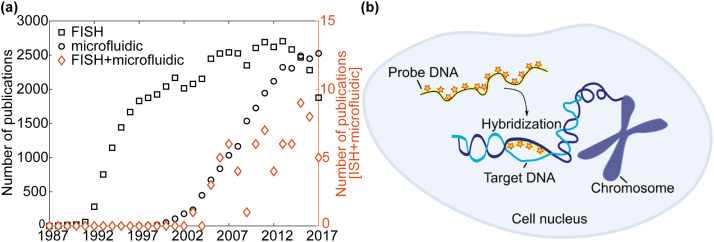Comprehensiveness of FISH Technology
FISH and Molecular Genetics
With the continuous upgrading of in situ hybridization technology and the continuous improvement of visualization methods, the molecular era of cytogenetics has arrived. Fluorescence in situ hybridization (FISH), as well as other in situ hybridization analysis protocols, allow researchers to locate the location of specific nucleic acid sequences. FISH is the detection method of choice for locating specific nucleic acid sequences in the natural environment, and its boundaries are constantly expanding. The popularity of FISH for nucleic acid detection is largely due to its wide range of applications and the relative ease of performing and performing in situ studies. Although the fundamentals of FISH have not changed, high-sensitivity detection, simultaneous detection of multiple species, and automated data collection and analysis have significantly advanced the field. During the maturation of FISH technology, various methods and modifications have been introduced to optimize the detection of DNA and RNA. FISH surpassed previously available techniques to become the most important analytical method for cytogenetics. Key methodological advances have eased the preparation of low-noise hybridization probes, and technological breakthroughs now allow for multi-target visualization and quantitative analysis. These factors make FISH broadly applicable to any nucleic acid-related analysis, and this technology has further significant implications for live-cell imaging and medical diagnostics.
 Fig 1. In situ hybridization – frequency of usage and implementation. (Huber D, et al. 2019)
Fig 1. In situ hybridization – frequency of usage and implementation. (Huber D, et al. 2019)
FISH Methods and Available Services in Cytogenetics
DNA/RNA associated with specific genomic regions or entire chromosomes can be visualized by FISH on a range of cytological and histological specimens. Our services for analyzing nucleic acids using FISH provide a range of analyses targeting specific DNA fragments on chromosomes or RNA during gene expression, including probe services, detection services, microscopy services, and data services. In addition to the experimental method, the most important thing that determines the quality of service is the quality of the probe. The probes currently used for FISH hybridization are usually deoxyribonucleic acid probes, and ribonucleic acid probes are only used in a few cases. We provide DNA probes with a choice of commercial products or custom solutions based on probe design. Our platform has a wealth of probe solutions, and experienced experts can also provide technical support for customer probe design, although this semi-custom approach takes longer than a fully customized method. Our molecular platform has the capability for comprehensive cellular analysis and histopathological analysis. The source of the target may come from cytogenetic preparations or paraffin-embedded tissue. After the probe is ready, it provides customers with high-quality analysis results through a series of optimized hybridization procedures and imaging services.
 Fig 2. Creative Bioarray's nucleic acid analysis related FISH service.
Fig 2. Creative Bioarray's nucleic acid analysis related FISH service.
Diverse FISH Analysis
- DNA FISH Service
- RNA FISH Service
- DNA-RNA FISH Service
- 3D FISH Services
- Immuno-FISH Services
Creative Bioarray provides comprehensive FISH and in situ visualization analysis solutions to help customers locate different types of nucleic acid molecules on samples. Our experimental platform has comprehensive DNA/RNA analysis capabilities and related downstream analysis capabilities. Experienced scientists and experimentalists will escort your cytogenetic analysis to find the best solution for your needs. You will benefit from our technical expertise and equipment platform. If you are interested in our services, please contact us for cooperation. We look forward to cooperating with you in the near future.
References
- Jiang J. Fluorescence in situ hybridization in plants: recent developments and future applications[J]. Chromosome Research, 2019, 27(3): 153-165.
- Huber D, von Voithenberg L V, Kaigala G V. Fluorescence in situ hybridization (FISH): history, limitations and what to expect from micro-scale FISH?[J]. Micro and Nano Engineering, 2018, 1: 15-24.
- Speicher M R, Carter N P. The new cytogenetics: blurring the boundaries with molecular biology[J]. Nature reviews genetics, 2005, 6(10): 782-792.
All products and services on this website are only suitable for non-medical purposes.


 Fig 1. In situ hybridization – frequency of usage and implementation. (Huber D, et al. 2019)
Fig 1. In situ hybridization – frequency of usage and implementation. (Huber D, et al. 2019) Fig 2. Creative Bioarray's nucleic acid analysis related FISH service.
Fig 2. Creative Bioarray's nucleic acid analysis related FISH service.



